From the Editor: Of Sledge Dogs and Bulldogs
The Qimuksiq Network
A Hunt for the Greenlandic Sled Dog’s Soul
The Arctic Nomads Post-Symposium Report
Bulldog with a Short Snout
Book Review: The World of Tivi Etok
IMHO: Staying the Path
Navigating This Site
Index of articles by subject
Index of back issues by volume number
Search The Fan Hitch
Articles to download and print
Ordering Ken MacRury's Thesis
Our comprehensive list of resources
Defining the Inuit Dog
Talk to The Fan Hitch
The Fan Hitch home page
Editor: Sue Hamilton
Webmaster: Mark Hamilton
The Fan Hitch, Journal
of the Inuit Sled Dog, is published four
times a year. It is available at no cost
online at: https://thefanhitch.org.
The Fan Hitch welcomes your letters, stories, comments and suggestions. The editorial staff reserves the right to edit submissions used for publication.
Contents of The Fan Hitch are protected by international copyright laws. No photo, drawing or text may be reproduced in any form without written consent. Webmasters please note: written consent is necessary before linking this site to yours! Please forward requests to Sue Hamilton, 55 Town Line Rd., Harwinton, Connecticut 06791, USA or mail@thefanhitch.org.
This site is dedicated to the Inuit Dog as well as related Inuit culture and traditions. It is also home to The Fan Hitch, Journal of the Inuit Sled Dog.
The Fan Hitch welcomes your letters, stories, comments and suggestions. The editorial staff reserves the right to edit submissions used for publication.
Contents of The Fan Hitch are protected by international copyright laws. No photo, drawing or text may be reproduced in any form without written consent. Webmasters please note: written consent is necessary before linking this site to yours! Please forward requests to Sue Hamilton, 55 Town Line Rd., Harwinton, Connecticut 06791, USA or mail@thefanhitch.org.
This site is dedicated to the Inuit Dog as well as related Inuit culture and traditions. It is also home to The Fan Hitch, Journal of the Inuit Sled Dog.
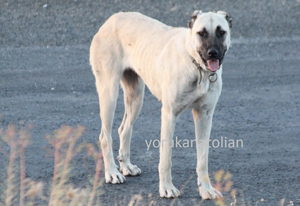
A sheep dog in Elazığ (Eastern Anatolia, Turkey) with very
strong hind knees and paws. The entirety of its qualities are
dictated and selected by lifestyle. This dog can run full speed
on hills covered with sharp stones. photo: G. Isik
Bulldog with a Short Snout
by Guvener Isik
Walkeringham, United Kingdom
August 10, 2016
It seems to me that pro-diversity and anti-inbreeding attitudes have become more than scientific positions. They are rather ideological and moral issues now. Many scientists are similar to TV talk show hosts. They always have something to bring up, stir a little bit, criticize, remain active so that they are paid attention to, and never conclude. I wonder what they actually produce and what percentage of them own and live with animals? Their papers are written according to scientific rules and terms and statistically inflated technical exhibitions, but they generally lack genuine thoughts because they are experts on minor details, which separate them from natural philosophers of the Renaissance.
M. Brophy Marcus, in her July 29, 2016 CBS news article, "Beloved dog breed may disappear due to health problems", quotes from Niels Pedersen, BS, DVM, PhD, UC Davis, California, "The English Bulldog truly is a breed in trouble." In Pedersen’s "A genetic assessment of the English bulldog", published 29 July 2016, he states, “Inbreeding ... has brought the breed to a crisis point. There are a whole litany of different problems associated with their structure and inbreeding. We were not surprised to find they did lack genetic diversity." Marcus narrates, via Pedersen, that many changes have occurred within the last couple of decades, as the dogs have been bred for results in increasingly stocky builds and shorter snouts. This apparently causes breathing problems. According to Pedersen, bulldogs live four to eight years as opposed to mutts living 15-17 years. Pedersen is already replicating and restating what is already known. Stressing the detrimental effects of inbreeding is almost advertising outbreeding as diversity; yet they are not equal. It almost has a political hue, saying, “Mixed is healthy.” I might as well say, “Gambling is bravery.”
All the above information may be correct, but the associations are not. A short snout causes breathing problems, but a short snout does not have to be the result of inbreeding. Is the problem inbreeding or the short snout? Is a long snout not the result of inbreeding? Being a mutt does not guarantee having a long life. It also does not ensure high intelligence or good health. I saw a twenty-six year-old Tibetan Mastiff in China and it was not a mutt! Presenting inbreeding almost as sin is the automatic reflexive action of the “liberated gene scientists”. It is by now clear to almost everyone, including the shepherds I know, that inbreeding allows detrimental traits to be expressed, but inbreeding could be a good tool as well. Inbreeding brings out positive traits along with negative ones. Inbreeding neither causes nor solves problems by itself.
Reduction in genetic variation can be bad. Yet this possibility by itself does not justify crossing wolves with dogs, because increased genetic variation will be equal to reduction in adaptation in the outbred wolf crosses.The real problem is concentrating certain traits in a few individuals that are not sustainable and then inbreeding those dogs.
If we were talking about another trait such as learning ability, no one would have argued against improving learning related traits in dogs by inbreeding. The scientist indicated the problem, but he presented his interpretation as difficulty in breathing because a short snout is the problem and inbreeding is the facilitator.
Inbreeding does not jam the process, as firing does not necessarily jam the mechanism of a gun. Subsequently, inbreeding is not a mechanism. It is a tool that can be employed in the process. A gun may be jammed because of continuous shooting. If so, we clean it once in a while. Or we may need to change the gun powder with another type to suit the metal or the casings. With the right pairing, the gun will shoot repeatedly without any trouble.It is not the inbreeding that pulls the trigger, but it chambers the bullet.
Instead of pulling either inbreeding or genetics out of the sack to explain every issue every time, like a remedy drug for any illness, selection of dogs before and after breeding and the conditions they are in must be given thought.Hoc opus, hic labor est – Here the work, here is the labor
The problem lies in the fact that the bulldog is no dog of bull. It is a name sold with a flat face and crooked teeth. If it were still a bull fighting dog as of today, I doubt it could have had any health problems. As we know, the real bull fighting dogs had longer snouts anyway. The problem is not only with this sadly freakish breed, but with its breeders, fans and perpetuators. What kind of extra peculiar minds would try to breed helpless organisms? One needs to start from this point.
Before leaving the inbreeding issue behind, let’s take a look at chickens.
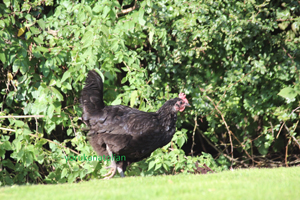
Anatolian Black Village Chicken that I own.This hen is very cautious
and ready to fly when she feels a threat. photo: G. Isik
I have Anatolian Black Mountain Village chickens (AC), New Hampshire X AC crosses and also Old English pheasant chickens. ACs are from a woman in my village in Turkey who inherited them from her mother-in-law. She claims that her twenty chickens and four roosters are from the same flock in the last fifty years without any external addition. This translates to at least forty generations of inbreeding. She calls them old native black chickens. Out of my three types of chickens, these are the most alert and intelligent. They are far more effective browsers and hardy in relation to the other two groups. I had one of my friends who keeps chickens acquire three of the ACs. His observation is the same. His single rooster converted his entire chicken flock into village chickens in the last five years. It seems that heavy inbreeding caused no problems for his flock in four generations. These chicken flocks, except for mine, have one common management: they are provided a coop, but they are not fed, vaccinated or managed. They fend for themselves, incubate their own eggs, sleep in the trees in summer and they only go into the barn in winter. This is one example of the health conditions of inbred aboriginal chickens. My un-scientific account above is a collection of observations. Starting with perfect genetics and keeping the organism in check with its environment is the key here.

A brown Anatolian Black Village Chicken with her
black chick. photo: G. Isik
When and how does an aboriginal landrace genetically become a cultured breed?
In the Turkish version of my book, The Sheep Dogs of Anatolia, I wrote, “…creating a breed or breeds out of a landrace population, which has no starting and ending point, is fundamentally wrong since doing so will result in the abolishment of the entire landrace population with all its subgroups and varieties.” The term “sheep dogs” can represent all the sheep dogs of Anatolia, and one can focus on certain varieties and even names if one wishes just like it has been done in Anatolia for centuries. “When one starts selecting relatively different individuals and pulling them out from the whole and breeding them in an isolated fashion, then the whole loses its integrity.”
When all your pigeons in a given loft are divers, but if you start classifying them according to their crests, muffs and color markings, which is forming a loft within the loft, then you are cutting the genetic connections among these three classes. Instead, when breeding is continued without isolating, but by recognizing these traits yet only taking the diving skills as the basic selection criterion for breeding, then all the other differences become supportive of each other at every generation and leaves the door ajar for potential new traits. We do not have to know how they support each other. They may be connected at several levels under different external stimuli or internal self-regulation based on polygenetic arrangements. We can focus on diving and let the birds’ genetic and physiological mechanisms take care of the rest. The criticism here may be that just like focusing on a short snout, we are focusing on harder diving skills. That is true, but the latter is about function whereas the former is about structure that serves no purpose other than disabling the organism. An Inuit Dog that successfully survives extreme cold conditions is expressing functionality, whereas one that is posing on the ice does not prove functionality. So the argument cannot be “too much cold tolerance is detrimental”, because it is like disqualifying a Saluki, because it is too fast.
The black brush goat flocks of Anatolia (BA) are managed like pigeons in a loft. When compared with Saanen, a BA flock is virtually an ocean that is connected with several rivers in terms of will to live, genetic depth and broadness. Saanen, though, is a lake. In this connection, a bulldog, because of the culture behind it, is a pond. If we cross a BA with a Saanen, we will have genetic diversity, because of outbreeding, but is any diversity equal to health by default? What keeps the BA healthy and strong are its genetic depth and selection without skipping generations, not mixture.
Genetic richness comes from within and is not equal to genetic diversity via mixture. Infrequent mixing can contribute to genetic depth only with intense filtering. Depth and richness stem from continuous historical success of a population in a given environment. BA runs on complexity with strict order, but not on mindless purity and arbitrary selection.An aboriginal race becomes a cultured breed when it is frozen in the name of conservation
When a Saluki does not hunt yet bred because of its genetic past, it becomes an item for exhibition; it is cultured through its protector. Going back to pigeons, I know people who would not let their pigeons fly, because they do not want hawks taking them. These people represent the decaying culture. The old generation put the pigeon in the harm’s way and they were the ones who came up with “smart” and fast birds.
Genetics are not good enough. Inheritance is not copying and pasting genetic codes forever without interruption. Genetic make-up has a memory and the tasks have to be reminded at every generation. Otherwise, qualities leak from the gene pool. What made a group of organisms good is needed to continue to make them good. In this regard, epigenetics is more explanatory than basic Mendelian genetics. The real conservation is not freezing, multiplying or replicating, but it is keeping the process that led to the organism to be conserved alive.
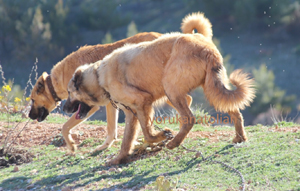
A bitch in heat is followed by a male dog that had just broke
its chain and is running free in the hills. Breeding result of
struggle is very much valued by shepherds. photo: G. Isik
Perhaps it was not any different for the Inuit Dog than it is for the Anatolians in the villages of Turkey. Every village is a pool of genes. These pools are sometimes connected, but they are still pools. Pools enable breeders to focus on certain traits and allow them to improve those. Connecting the pools is trading goods only when needed. Constant trading leads to exchanging, but not to focused production and progress.
Neither inbreeding nor outbreeding is sin. Nevertheless, only outcrossing can solve inbreeding depression. Yet, bringing vigor by outcrossing is a one-generation success. It rapidly fades in the following generations. It is printing money without backing it up with tangible assets.As spending is not feasible without saving first, outbreeding is impossible without inbreeding. An already mixed population cannot be further mixed, but a high enough multiplication rate will, although infrequently, allow variation within the population. A small breeding population whether inbred or outbred, will reach a saturation point resulting in no more new gene combinations and the entire population becomes the same in terms of average likeness. In the Anatolian villages, inbreeding is not abused and it is not forever.
A sudden outcross from the same class is acceptable. As long as the main concern is functionality and health, both can be employed at different degrees.
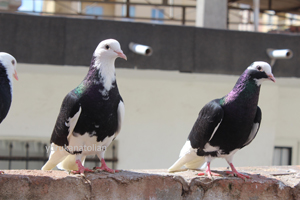
Dönek diving pigeon just landed. Even when they are idle
it is easy to see their strong wings. photo: G. Isik
Here, I will provide a pigeon breeding example: Saya is a diving breed in Turkey, with 14 tail feathers and its legs are muffed. These two qualities are not seen in rock pigeons that have 12 retrices [any of the comparatively large, stiff feathers of a bird's wing or tail that are necessary for flight] yet some Sayas are blue with black bands on their wings. How come a clearly wild trait remains in this breed? Although theoretically it has been there from the very beginning, this trait came in and can be brought in by outbreeding Sayas with rock pigeons. Once the trait was in, the rest of the wild rock traits were exhausted by inbreeding. (Shepherds did the same when they crossed their dogs with wolves.) In order to go back to two Saya traits, the cross offspring has to be bred back to Sayas for at least three generations. This is not accomplished by breeding the F1 generation to any Saya, but only to the best diving bird, since the breeder wants this new color only if it also has the best flying skills. The breeder may choose a sudden outcross for the purpose of borrowing a trait, but he then returns to heavy inbreeding. This is not blending, mixing and diversifying. This is, while watching the wind and other elements, sailing towards a set goal in a focused manner. These non-scientists, no record keeping “laymen” can manage it by following the dominant traits and moving them in the best flying birds’ line. They keep the breeding population as small as possible in order not to lose any desired traits. It is not necessary to enter the details of how they do it, but this gives an idea about closed population breeding aiming at function. Their end result is “pure” Sayas with blue feathers. They are pure, because they perform impeccably, exactly like other Sayas. These blue Sayas may not be genetically “the same”, but functions-wise, they are. Once the breeder reaches his desired level of purity based on flying skills, then he does not split the offspring to breed back to the grandpa/ma anymore and lets them breed as brothers and sisters for several generations while continuing performance based selection.
Chasing genetic purity is focusing on the story-telling of a war. Chasing – work equals force times distance – is focusing on the victory. In this sense, I am as ignorant as I can be to the DNA component of this purity obsession. It is for armchair experts. And who knows, perhaps the new impure line of Sayas will become the norm and the new “pure” for a while. And why do these aboriginal pigeon people want to add a new color? Isn’t their purpose only the performance? That does not mean that they have no appreciation for aesthetics. However, the rock pigeon does not only bring color, but vigor, speed, hardiness and intelligence as well. Pigeon people value flying ability in relation to smartness. That’s why they frequently use the term “smart bird”. No pigeon exhibitionist need to use this term, since their pigeons have smaller brains any way.
Are aboriginal and cultured landraces genetically the same, but is the latter just a very diluted, functionally inferior version of the same thing?Genetic purity maintains the organism’s healthonly when it comes with functionality.
The answer lies in “Pietas et fatum – duty and mission”.
In the absence of corrective and structuring conditions, “cultured landraces” (where non-original culture tries to set the norms for the landrace in the name of the original culture) are the product of internal deviation. They are inferior and self-diluted. When nomads sell a goat to a sedentary villager, they would not take it back and add it to their flocks. They see that it is not the same goat anymore. It cannot perform the same.They are genetically similar, but not the same.
The Anatolian Shepherd Dog is an “aboriginal club-race” dog. The working sheep dogs of Anatolia are “aboriginal landrace” dogs. They are not the same dogs. The latter is the product of uninterrupted process. The former is the collection of invaded, captured, arrested, collectivized and regulated gene mass that can perform very little. They are not held to some standard of conduct or accomplishment.Based on my communication with breeders in the US, even a one month-old American Anatolian pup does not have the same level of will to live and has less vigor than a village Anatolian in Turkey. So the breeders might have started with superior dogs, but they did not continue with them, because it takes heart, commitment, “pietas et fatum”.
Courage and opus (work ethic) cannot be registered.
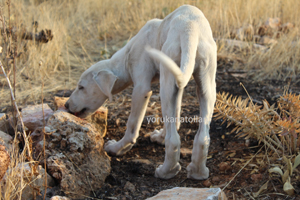
A free stray pup that I found with very strong hind legs
that is acquired by condition. photo: G. Isik
Domestic dogs, goats, horses, chickens and pigeons relatively revert back to their wild types when they are not regulated by man. Goats left on an island become inbred, but they strain out all the impurities and defects generation after generation in their own internal ways. We may not be able to see that they become the original wild ancestor, but they clearly deviate too far from their domestic starting point, and approach the wild end of the spectrum. This will not happen in any closed population in a farm environment. The regulation needs to come from the goats’ direct interaction with nature, without any input from man. I doubt we can accomplish this by releasing bulldogs on an island or in a pastoral village. It is too late for them to rejuvenate themselves and restore the original wild qualities. If we were to replicate the same with, for example, Inuit Dog X other sled dog breed or Anatolian X Labrador Retriever crosses, based on my observations in Saanens in BA flocks, New Hampshire chickens in AC flocks and pointer sheep dog crosses tried under village conditions, the population would start shedding any trait that becomes a burden under the circumstances and march towards a more efficiency oriented type.
Landrace animals are the result of limited input of man. The rule for the man of the landrace is to “keep excellent specimens and do not fix them until they do not serve the purpose anymore.”Guvener Isik has been a cheese and wine maker in Turkey, sheep and goat owner, and information technology consultant. He has a psychology degree and MBA. He developed a great interest in sheep dogs and nomads while growing up in Turkey and rural Anatolia in 1970s and ‘80s. He began travelling specifically to the sheep and goat regions in Anatolia in order to observe the dogs in their native conditions and to learn directly from the shepherds. Additionally, he advocates understanding sheep dogs principally through their interactions with sheep and goats in the culture that originally developed and made perfect use of these dogs. He is the author of The Sheep Dogs of Anatolia: Yörük Koyçıs (July 31, 2014). Guvener Isik and his family reside in the UK and Turkey.
Ed: This article has been formatted for a print version and can be found in the Health, Science and Ethology section of our “Articles to download and print” page.